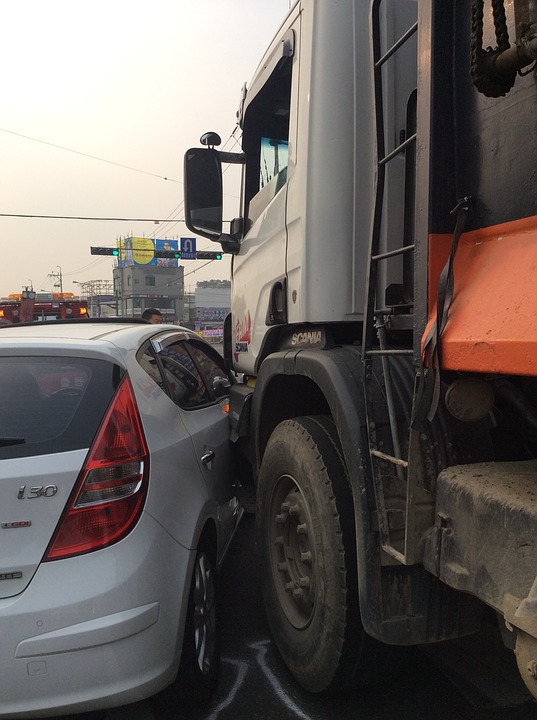Blog

Tips for Safe Driving Near Trucks
Driving around commercial trucks can be dangerous, so always take extra precautions. The risk of an accident increases with these vehicles because they have larger blind spots, cannot maneuver as easily, and take longer to stop than passenger vehicles. Use these to your advantage, and keep the following tips in mind to reduce the overall risks for an accident when driving beside a truck.
AVOID BLIND SPOTS
Big rigs and other large vehicles have much larger blind-spot areas than traditional passenger vehicles: This can make it much more difficult for a truck driver to see an approaching vehicle. When driving around a commercial truck, try to avoid the following areas:
20 feet ahead of the truck
30 feet behind the truck
The lane on the driver’s side extending back to half of the trailer’s length
Two lanes wide on the truck’s right side
- Take extra precautions at intersections and inclines
Semi-trailer trucks take more room than passenger cars to make turns, and the cab and trailer both follow a different path. A truck may need to swing left to gain room for a right turn or may start a turn from the middle lane of traffic.
Do not attempt to pass a truck that has a turn signal on, and do not drive between the truck and the curb. When at a stop at an intersection, make sure your vehicle is safely behind the line, because trucks need that space to make turns.
Pass Safely
Because commercial trucks require more time to stop and maneuver through traffic, you should exercise caution when passing a commercial truck. It is always wise to pass another vehicle safely. However, careful passing is even more important near a commercial truck, because the large, heavy vehicles cannot stop as quickly as a passenger vehicle. Truck drivers need time to react and adjust their speed and brake accordingly. It is easier for a truck driver to see you if you are traveling on the truck’s left side. Pass on the left while maintaining your speed and signaling properly. Wait to merge back into the truck’s lane until you can view its driver in your rearview mirror. When a truck passes you, slow down to allow plenty of space in front of you for the driver to maneuver safely and efficiently.
Be patient.
Big rigs don’t operate the same way cars do and may take longer to accelerate. Don’t be aggressive, or you could cause a distraction that leads to an accident. Truck drivers have strict operating rules to follow and often use regulating devices, such as a speed limiter which restricts vehicle speed. Honking, aggressive driving, or maneuvering through traffic will not encourage a commercial driver to speed up. Instead, it could put you in danger of causing an accident
Give the truck plenty of space
Always keep a driving distance of at least four seconds between your vehicle and a commercial truck. If you are tailgating a big rig, the driver cannot see you. If you cannot stop in time or are rear-ended while traveling closely behind a large truck, your car may be pushed underneath the trailer -- a type of collision that tends to be catastrophic.
Furthermore, driving too close to a commercial truck increases the likelihood of being involved in an accident. This can occur when:
The commercial truck breaks suddenly, causing the vehicle to tip over or your vehicle to slide under its trailer
High winds cause rollovers
Tire blowouts, that could hit your vehicle or shatter your windshield
- Adjust Your Headlights
Always keep in mind that your headlights could blind a truck driver as they reflect off the truck’s large mirrors. The bright light from your vehicle’s headlights could impair the truck’s driver and may affect his or her ability to safely operate the vehicle.
For this reason, you should lower your vehicle’s high beams anytime you see an oncoming truck or other vehicle approaching you on the roadway.
- WEAR YOUR SEAT BELT
Wearing a seat belt will protect you in the event of a truck accident and is one of the most effective measures you can take to reduce the risk of suffering an injury or death Always buckle kids in the back seat, in approved car seats if applicable.
- DO NOT DRIVE DROWSY
Driving while drowsy and fatigued is dangerous. If you are tired, get off the road and rest. When on long trips, allow time for rest breaks or have another driver who can relieve you when you become tired.
- DO NOT DRIVE UNDER THE INFLUENCE
Alcohol and drugs impair your reaction time and judgement – a deadly combination when driving. Even over-the-counter or prescription medications can cause side effects that make driving dangerous. Never drive under the influence of these substances.
Posted on October 2019,22 // Author: Admin